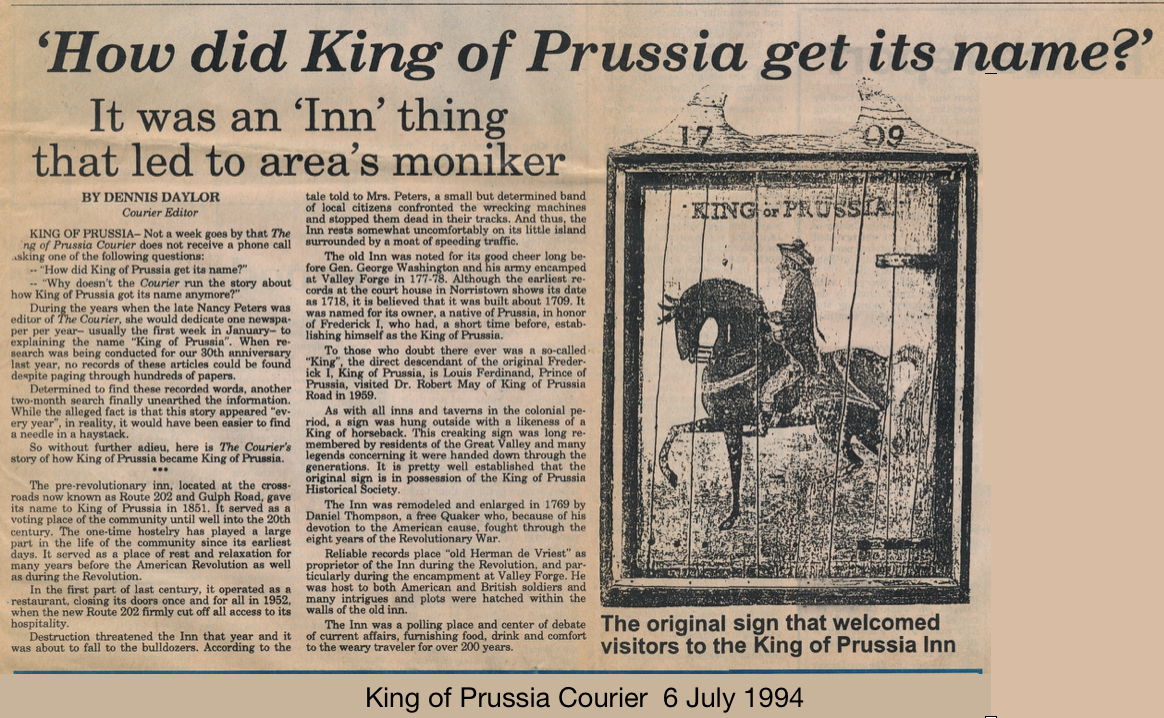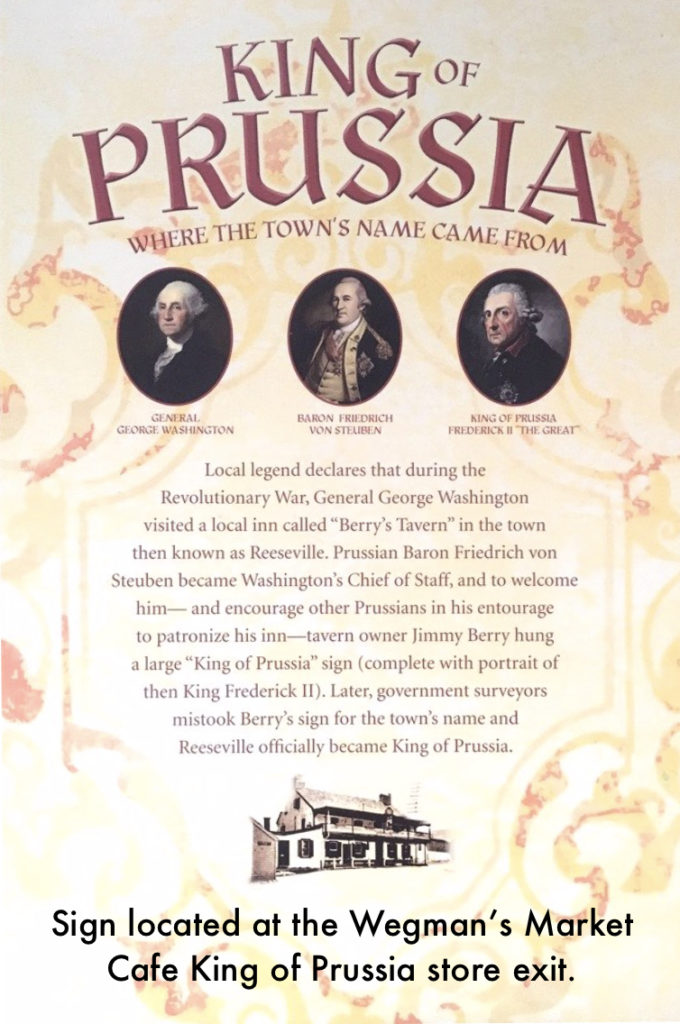To start off the New Year, here’s some history from Ed Dybicz, Upper Merion Historian, the King of Prussia Courier (which used to “dedicate one newspaper per year – usually the first week in January – to explaining the name King of Prussia“) along with what you’ll find at our local Wegman’s on the topic.
No, King of Prussia Wasn’t Named by Early German Settlers
By Ed Dybicz ~ 9 January 1974 ~ King of Prussia Courier
Over a period to time, many new residents of Upper Merion have wanted to know, “When did the Germans settle in King of Prussia?”
These residents and other newcomers to Upper Merion are apparently misled by the village’s name, “King of Prussia,” which honors Frederick II, called Frederick The Great, King of Prussia (1712-1786).
The village name was adopted in 1850. It was named after King of Prussia Inn, which was built in 1769. The region was not settled by any Germans, however, but by the Welsh.
Several persons have asserted that the King of Prussia Inn was built in 1709. One obstacle to accepting that date is the lack of documentary evidence. The late Edward Hocker, one of Montgomery county’s eminent historians, wrote, “There is every reason to believe the inn was built in 1769.”
More definite proof of this date is contained in a letter written by J. Sturgis McCord. A paragraph from the letter reads: “Daniel Thompson in 1769 built the King of Prussia Inn. He was a Free Quaker and fought in the Revolution.” Daniel Thompson was the grandfather of J. Sturgis McCord.
Mrs. Jane Keplinger Burris – historian, researcher, and former librarian of the Historical Society of Montgomery County – pointed out that it is more likely the ground was deeded in 1709, than it is that the inn was constructed then.
Because there were no Germans living in the area, it appears likely that an admirer of Frederick II, King of Prussia, named the inn.
The village which is now King of Prussia, around the intersection of DeKalb Pike (formerly Swedesford Rd.) and Gulph Rd., was founded in 1819 and was originally called “Reesville” for the Welsh family of Rees. A post office with that name was opened in 1820.
There were a few early Germans who settled in Upper Merion. But there weren’t sufficient numbers of them to establish a village, as did the Swedes. the German immigration in this general area took place mainly in the Perkiomen Valley and in the upper end of Montgomery county. German names are applied to communities such as Trappe, Franconia, and Frederick.
And, in 1683 – less than a year after the landing of William Penn – a colony of Germans, chiefly from Creisheim and Creyfelt, were led by Francis Daniel Pastorius, they arrived and founded the village of Germantown, now part of Philadelphia.
During the Revolutionary War, thousands of Germans volunteered. One of their leaders was the fiery Peter Muhlengerg, pastor of a Lutheran Church.
In 1776 he ascended the pulpit and preached a blazing sermon in which he declared, “There is a time for preaching and praying, but also a time for battle, and that time has now arrived.” Muhlenberg then flung aside his ministerial robes to reveal a uniform of the Continental Army.
Gen. Muhlenberg made his headquarters during the Winter Encampment at Valley Forge in 1777-78 at the Moore Farm in the Port Kennedy area of Upper Merion. This site today is owned by the Upper Merion Cultural Center and surrounded by the King of Prussia Industrial Park.
Other Germans in the American Revolutionary Army who tred upon the soil of Upper Merion were Maj. Gen. von Steuben, Gen. Johann de Kalb, Dr. Bodo Otto (senior surgeon), Christopher Ludwig (the baker general), Jacob Hiltzheimer (commissioner of horses), Col. Ludwig Farmer and Capt. Leonhard Jacoby.
Another German here was Nicholas Herkimer of New York, who in August of 1777 commanded the American forces to victory at the Battle of Oriskany. His four battalions had German colonels.
Records at the Historical Society of Montgomery County and other sources indicate there were several other well-known German settlers in Upper Merion over a period of years.


